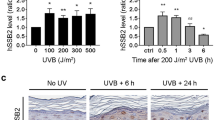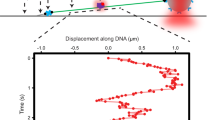Abstract
Mutations in the nucleotide excision repair (NER) pathway can cause the xeroderma pigmentosum skin cancer predisposition syndrome. NER lesions are limited to one DNA strand, but otherwise they are chemically and structurally diverse, being caused by a wide variety of genotoxic chemicals and ultraviolet radiation. The xeroderma pigmentosum C (XPC) protein has a central role in initiating global-genome NER by recognizing the lesion and recruiting downstream factors. Here we present the crystal structure of the yeast XPC orthologue Rad4 bound to DNA containing a cyclobutane pyrimidine dimer (CPD) lesion. The structure shows that Rad4 inserts a β-hairpin through the DNA duplex, causing the two damaged base pairs to flip out of the double helix. The expelled nucleotides of the undamaged strand are recognized by Rad4, whereas the two CPD-linked nucleotides become disordered. These findings indicate that the lesions recognized by Rad4/XPC thermodynamically destabilize the Watson–Crick double helix in a manner that facilitates the flipping-out of two base pairs.
This is a preview of subscription content, access via your institution
Access options
Subscribe to this journal
Receive 51 print issues and online access
$199.00 per year
only $3.90 per issue
Buy this article
- Purchase on SpringerLink
- Instant access to full article PDF
Prices may be subject to local taxes which are calculated during checkout




Similar content being viewed by others
Change history
04 October 2007
The Correspondence email address got updated on 4 October 2007, but in HTML only.
References
Cleaver, J. E. Cancer in xeroderma pigmentosum and related disorders of DNA repair. Nature Rev. Cancer 5, 564–573 (2005)
Gillet, L. C. & Scharer, O. D. Molecular mechanisms of mammalian global genome nucleotide excision repair. Chem. Rev. 106, 253–276 (2006)
Legerski, R. & Peterson, C. Expression cloning of a human DNA repair gene involved in xeroderma pigmentosum group C. Nature 359, 70–73 (1992)
Masutani, C. et al. Purification and cloning of a nucleotide excision repair complex involving the xeroderma pigmentosum group C protein and a human homologue of yeast RAD23. EMBO J. 13, 1831–1843 (1994)
Riedl, T., Hanaoka, F. & Egly, J.-M. The comings and goings of nucleotide excision repair factors on damaged DNA. EMBO J. 22, 5293–5303 (2003)
Sugasawa, K. et al. Xeroderma pigmentosum group C protein complex is the initiator of global genome nucleotide excision repair. Mol. Cell 2, 223–232 (1998)
Batty, D., Rapic'-Otrin, V., Levine, A. S. & Wood, R. D. Stable binding of human XPC complex to irradiated DNA confers strong discrimination for damaged sites. J. Mol. Biol. 300, 275–290 (2000)
Kusumoto, R. et al. Diversity of the damage recognition step in the global genomic nucleotide excision repair in vitro . Mutat. Res. 485, 219–227 (2001)
Hey, T. et al. The XPC–HR23B complex displays high affinity and specificity for damaged DNA in a true-equilibrium fluorescence assay. Biochemistry 41, 6583–6587 (2002)
Volker, M. et al. Sequential assembly of the nucleotide excision repair factors in vivo . Mol. Cell 8, 213–224 (2001)
Dip, R., Camenisch, U. & Naegeli, H. Mechanisms of DNA damage recognition and strand discrimination in human nucleotide excision repair. DNA Repair 3, 1409–1423 (2004)
Fitch, M. E., Nakajima, S., Yasui, A. & Ford, J. M. In vivo recruitment of XPC to UV-induced cyclobutane pyrimidine dimers by the DDB2 gene product. J. Biol. Chem. 278, 46906–46910 (2003)
Madura, K. Rad23 and Rpn10: perennial wallflowers join the melee. Trends Biochem. Sci. 29, 637–640 (2004)
Masutani, C. et al. Identification and characterization of XPC-binding domain of hHR23B. Mol. Cell. Biol. 17, 6915–6923 (1997)
Ng, J. M. Y. et al. A novel regulation mechanism of DNA repair by damage-induced and RAD23-dependent stabilization of xeroderma pigmentosum group C protein. Genes Dev. 17, 1630–1645 (2003)
Ortolan, T. G., Chen, L., Tongaonkar, P. & Madura, K. Rad23 stabilizes Rad4 from degradation by the Ub/proteasome pathway. Nucleic Acids Res. 32, 6490–6500 (2004)
Cosman, M. et al. Solution conformation of the (-)-cis-anti-benzo[a]pyrenyl-dG adduct opposite dC in a DNA duplex: intercalation of the covalently attached BP ring into the helix with base displacement of the modified deoxyguanosine into the major groove. Biochemistry 35, 9850–9863 (1996)
Mao, B. et al. Solution structure of the (+)-cis-anti-benzo[a]pyrene-dA ([BP]dA) adduct opposite dT in a DNA duplex. Biochemistry 38, 10831–10842 (1999)
de los Santos, C. et al. Influence of benzo[a]pyrene diol epoxide chirality on solution conformations of DNA covalent adducts: the (-)-trans-anti-[BP]ĠC adduct structure and comparison with the (+)-trans-anti-[BP]ĠC enantiomer. Biochemistry 31, 5245–5252 (1992)
Geacintov, N. E. et al. Thermodynamic and structural factors in the removal of bulky DNA adducts by the nucleotide excision repair machinery. Biopolymers 65, 202–210 (2002)
O'Handley, S. F. et al. Structural characterization of an N-acetyl-2-aminofluorene (AAF) modified DNA oligomer by NMR, energy minimization, and molecular dynamics. Biochemistry 32, 2481–2497 (1993)
Kim, J. K. & Choi, B. S. The solution structure of DNA duplex-decamer containing the (6-4) photoproduct of thymidylyl(3'→5')thymidine by NMR and relaxation matrix refinement. Eur. J. Biochem. 228, 849–854 (1995)
McAteer, K., Jing, Y., Kao, J., Taylor, J. S. & Kennedy, M. A. Solution-state structure of a DNA dodecamer duplex containing a cis-syn thymine cyclobutane dimer, the major UV photoproduct of DNA. J. Mol. Biol. 282, 1013–1032 (1998)
Jing, Y., Kao, J. F. & Taylor, J. S. Thermodynamic and base-pairing studies of matched and mismatched DNA dodecamer duplexes containing cis-syn, (6-4) and Dewar photoproducts of TT. Nucleic Acids Res. 26, 3845–3853 (1998)
Gunz, D., Hess, M. T. & Naegeli, H. Recognition of DNA adducts by human nucleotide excision repair. Evidence for a thermodynamic probing mechanism. J. Biol. Chem. 271, 25089–25098 (1996)
Buterin, T. et al. Unrepaired fjord region polycyclic aromatic hydrocarbon–DNA adducts in ras codon 61 mutational hot spots. Cancer Res. 60, 1849–1856 (2000)
Gao, Y. G., Robinson, H., Sanishvili, R., Joachimiak, A. & Wang, A. H. Structure and recognition of sheared tandem ĠA base pairs associated with human centromere DNA sequence at atomic resolution. Biochemistry 38, 16452–16460 (1999)
Chou, S. H. & Chin, K. H. Solution structure of a DNA double helix incorporating four consecutive non-Watson–Crick base-pairs. J. Mol. Biol. 312, 769–781 (2001)
Sugasawa, K. et al. A multistep damage recognition mechanism for global genomic nucleotide excision repair. Genes Dev. 15, 507–521 (2001)
Buterin, T., Meyer, C., Giese, B. & Naegeli, H. DNA quality control by conformational readout on the undamaged strand of the double helix. Chem. Biol. 12, 913–922 (2005)
Anantharaman, V., Koonin, E. V. & Aravind, L. Peptide-N-glycanases and DNA repair proteins, Xp-C/Rad4, are, respectively, active and inactivated enzymes sharing a common transglutaminase fold. Hum. Mol. Genet. 10, 1627–1630 (2001)
Ikegami, T. et al. Solution structure of the DNA- and RPA-binding domain of the human repair factor XPA. Nature Struct. Biol. 5, 701–706 (1998)
Buschta-Hedayat, N., Buterin, T., Hess, M. T., Missura, M. & Naegeli, H. Recognition of nonhybridizing base pairs during nucleotide excision repair of DNA. Proc. Natl Acad. Sci. USA 96, 6090–6095 (1999)
Yang, Z. et al. Specific and efficient binding of xeroderma pigmentosum complementation group A to double-strand/single-strand DNA junctions with 3′- and/or 5′-ssDNA Branches. Biochemistry 45, 15921–15930 (2006)
Wang, M., Mahrenholz, A. & Lee, S. H. RPA stabilizes the XPA-damaged DNA complex through protein–protein interaction. Biochemistry 39, 6433–6439 (2000)
Buchko, G. W. et al. DNA–XPA interactions: a 31P NMR and molecular modeling study of dCCAATAACC association with the minimal DNA-binding domain (M98–F219) of the nucleotide excision repair protein XPA. Nucleic Acids Res. 29, 2635–2643 (2001)
Camenisch, U., Dip, R., Schumacher, S. B., Schuler, B. & Naegeli, H. Recognition of helical kinks by xeroderma pigmentosum group A protein triggers DNA excision repair. Nature Struct. Mol. Biol. 13, 278–284 (2006)
Sugasawa, K., Shimizu, Y., Iwai, S. & Hanaoka, F. A molecular mechanism for DNA damage recognition by the xeroderma pigmentosum group C protein complex. DNA Repair 1, 95–107 (2002)
Cosman, M. et al. Solution conformation of the (+)-trans-anti-[BPh]dA adduct opposite dT in a DNA duplex: intercalation of the covalently attached benzo[c]phenanthrene to the 5′-side of the adduct site without disruption of the modified base pair. Biochemistry 32, 12488–12497 (1993)
Cosman, M. et al. Solution conformation of the (-)-trans-anti-benzo[c]phenanthrene-dA ([BPh]dA) adduct opposite dT in a DNA duplex: intercalation of the covalently attached benzo[c]phenanthrenyl ring to the 3′-side of the adduct site and comparison with the (+)-trans-anti-[BPh]dA opposite dT stereoisomer. Biochemistry 34, 1295–1307 (1995)
Huffman, J. L., Sundheim, O. & Tainer, J. A. DNA base damage recognition and removal: new twists and grooves. Mutat. Res. 577, 55–76 (2005)
Cheng, X. & Blumenthal, R. M. Finding a basis for flipping bases. Structure 4, 639–645 (1996)
DeLano, W. L. The PyMOL Molecular Graphics System 〈http://www.pymol.org〉 (2002)
Yang, A. et al. Flexibility and plasticity of human centrin 2 binding to the xeroderma pigmentosum group C protein (XPC) from nuclear excision repair. Biochemistry 45, 3653–3663 (2006)
Thompson, J. R., Ryan, Z. C., Salisbury, J. L. & Kumar, R. The structure of the human centrin 2-xeroderma pigmentosum group C protein complex. J. Biol. Chem. 281, 18746–18752 (2006)
Otwinowski, Z. & Minor, W. Processing of x-ray diffraction data collected in oscillation mode. Methods Enzymol. 276, 307–326 (1997)
de La Fortelle, E. & Bricogne, G. Maximum-likelihood heavy-atom parameter refinement for multiple isomorphous replacement and multiwavelength anomalous diffraction methods. Methods Enzymol. 276, 472–494 (1997)
Jones, T. A., Zou, J. Y., Cowan, S. W. & Kjeldgaard, M. Improved methods for binding protein models in electron density maps and the location of errors in these models. Acta Crystallogr. A 47, 110–119 (1991)
Brunger, A. T. et al. Crystallography and NMR system: A new software suite for macromolecular structure determination. Acta Crystallogr. D 54, 905–921 (1998)
The CCP4 suite: programs for protein crystallography. Acta Crystallogr. D 50, 760–763 (1994)
Acknowledgements
We thank D. King for mass spectroscopic analysis; H. Erdjument-Bromage for N-terminal sequencing; the staff of the Advanced Photon Source ID-24 and 8-BM beamlines for help with data collection; M. Minto for administrative assistance; and Y. Goldgur, A. Wong, A. Smalls-Mantey, A. Rozenbaum and the members of the Pavletich laboratory for help and discussions. This work was supported by the NIH and the Howard Hughes Medical Institute. J.-H.M. was supported by the Leukemia & Lymphoma Society as a Special Fellow.
Coordinates and structure factors of the Rad4–Rad23 and Rad4–Rad23–DNA complexes have been deposited in the Protein Data Bank under accession code 2QSF (Rad4–Rad23), 2QSG (Rad4–Rad23 bound to CPD-mismatch DNA) and 2QSH (Rad4–Rad23 bound to mismatch-only DNA).
Author information
Authors and Affiliations
Corresponding author
Ethics declarations
Competing interests
Reprints and permissions information is available at www.nature.com/reprints. The authors declare no competing financial interests.
Supplementary information
Supplementary Information
This file contains Supplementary Tables 1–2, Supplementary Figures 1–7 with Legends, and Supplementary Discussion. Supplementary Table 1 contains crystallographic statistics. Supplementary Table 2 contains DNA sequences used for crystallization and EMSA. Supplementary Figures and Discussion contain detailed characterization/description of the Rad4–Rad23 complex and its apo- and DNA-bound crystal structures presented in the paper. (PDF 2140 kb)
Rights and permissions
About this article
Cite this article
Min, JH., Pavletich, N. Recognition of DNA damage by the Rad4 nucleotide excision repair protein. Nature 449, 570–575 (2007). https://doi.org/10.1038/nature06155
Received:
Accepted:
Published:
Issue Date:
DOI: https://doi.org/10.1038/nature06155



